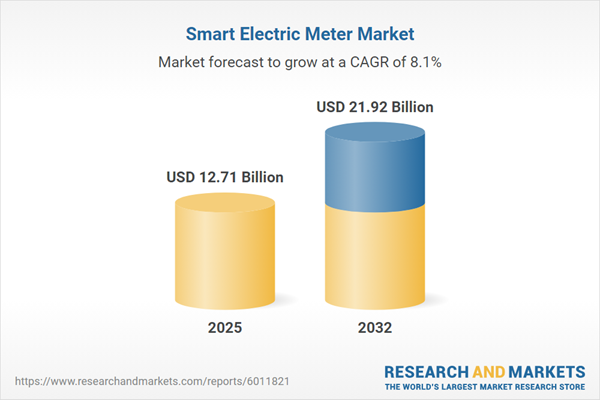Speak directly to the analyst to clarify any post sales queries you may have.
The smart electric meter market is evolving rapidly as power utilities respond to digital transformation needs, regulatory shifts, and the demand for advanced metering infrastructure. Senior decision-makers face increasing pressure to balance technology adoption with compliance and operational efficiency—trends that will define their approach to grid modernization and resource optimization.
Market Snapshot: Growth and Dynamics in the Smart Electric Meter Market
The global smart electric meter market is projected to grow from USD 11.74 billion in 2024 to USD 12.71 billion in 2025, ultimately reaching USD 21.92 billion by 2032 at a compound annual growth rate (CAGR) of 8.11%. Key drivers include increasing demand for real-time energy data, the push for modernization of utility networks, and greater uptake of digital energy management by operators. Advanced metering technologies are being deployed to improve infrastructure performance, advance decarbonization strategies, and adapt to new regulatory environments. At the same time, competition is intensifying as solution providers expand their offers and customize solutions for diverse market and compliance requirements across regions.
Scope & Segmentation: Industry Ecosystem and Technology Integration
- Offerings: Advanced hardware spans next-generation metering units and integrated communication modules, paired with robust software for meter management, analytics, and ongoing professional services including consulting, integration, installation, and asset lifecycle support.
- Connectivity Technologies: Solutions leverage cellular, Ethernet, power line communication, and radio frequency mesh for adaptable and secure deployments in both urban and rural utility networks, supporting a range of regulatory mandates worldwide.
- Applications: Smart metering platforms address commercial, industrial, residential, and utility needs, providing detailed analytics for energy usage and supporting operational optimization and predictive decision-making.
- Meter Types: Single phase and three phase smart meters are designed for diverse load profiles, ensuring flexible compatibility from smaller commercial entities to large-scale industrial sites.
- End Users: Commercial enterprises, industrial complexes, and residential customers receive valuable insights into energy consumption, fostering transparency and targeted efficiency enhancements.
- Installation Types: Solutions are suitable for both new construction projects and retrofit scenarios, delivering seamless integration with current and next-generation infrastructure to future-proof investments.
- Regional Segments: The Americas, Europe, Middle East, Africa, and Asia-Pacific each reflect unique patterns of technology adoption, driven by different regulatory frameworks, modernization priorities, and tailored vendor strategies.
- Key Industry Players: Leading smart meter companies—such as Landis+Gyr AG, Itron, Siemens Aktiengesellschaft, Schneider Electric SE, Honeywell International Inc., Elster Solutions LLC, Xylem Inc., Kamstrup A/S, Iskraemeco d.o.o., and EDMI Limited—are shaping market direction with comprehensive portfolios and strategic service integration.
Key Takeaways: Strategic Insights for Decision-Makers
- Utilities are adopting artificial intelligence and edge computing to enhance asset maintenance and improve real-time responsiveness within smart meter deployments.
- Advanced analytics enable more timely and precise assessments of consumption patterns, supporting demand management and helping utilities fine-tune grid operations.
- Organizations are prioritizing infrastructure upgrades and advanced data privacy to align with changing compliance frameworks, directly impacting procurement and investment strategies.
- Collaboration with leading technology vendors and system integrators is key to successfully managing sophisticated smart grid implementations and achieving sustainable project objectives.
- With shifting regional regulations, utilities value flexible engagement models focused on compliance, allowing more targeted adaptation to specific policy requirements.
- Modular smart metering solutions are supporting supply chain resilience, equipping utilities to adjust rapidly to evolving network conditions and manage operational risks effectively.
Tariff Impact: Navigating Pricing and Supply Chain Strategy
Forthcoming US tariff changes in 2025 are anticipated to impact the pricing structure of core components, such as communication modules and semiconductors, throughout the smart electric meter ecosystem. To address these pressures, manufacturers are exploring nearshoring alternatives and rethinking procurement strategies to maintain stable operations amidst price shifts. Utilities are also moving toward flexible contracts and subscription-based software models, integrating modular metering solutions to support consistent performance and robust supply chain management in a shifting trade environment.
Methodology & Data Sources
This market intelligence is grounded in direct interviews with energy sector leaders, comprehensive secondary research, and triangulated primary analysis. Findings have been validated by an independent expert panel to ensure actionable insights and credibility for executive decision-making.
Why This Report Matters: Actionable Insights for Senior Leaders
- Explains how new technologies and regulatory shifts are altering procurement, infrastructure planning, and capital allocation for the energy sector.
- Identifies regional opportunities and compliance considerations, helping senior teams build effective market-entry and grid modernization strategies.
- Delivers clear market segmentation, supporting resource deployment, competitive benchmarking, and long-range planning.
Conclusion: Smart Electric Meter Market Outlook
The smart electric meter market is positioned for continued advancement as innovation and regulatory change reshape utility operations. Forward-thinking organizations that align technology investment with evolving standards will reinforce their market role and sustained operational resilience.
Additional Product Information:
- Purchase of this report includes 1 year online access with quarterly updates.
- This report can be updated on request. Please contact our Customer Experience team using the Ask a Question widget on our website.
Table of Contents
3. Executive Summary
4. Market Overview
7. Cumulative Impact of Artificial Intelligence 2025
Companies Mentioned
The companies profiled in this Smart Electric Meter market report include:- Landis+Gyr AG
- Itron, Inc.
- Siemens Aktiengesellschaft
- Schneider Electric SE
- Honeywell International Inc.
- Elster Solutions LLC
- Xylem Inc.
- Kamstrup A/S
- Iskraemeco d.o.o.
- EDMI Limited
Table Information
| Report Attribute | Details |
|---|---|
| No. of Pages | 199 |
| Published | October 2025 |
| Forecast Period | 2025 - 2032 |
| Estimated Market Value ( USD | $ 12.71 Billion |
| Forecasted Market Value ( USD | $ 21.92 Billion |
| Compound Annual Growth Rate | 8.1% |
| Regions Covered | Global |
| No. of Companies Mentioned | 11 |









